Auto Provision Grandstream IP Phone with Yeastar P-Series PBX System
This topic takes Grandstream GPR2602 (firmware: 1.0.3.67) as an example to introduce how to auto provision a Grandstream IP phone with Yeastar P-Series PBX System in Local Area Network (LAN).
Requirements
The firmwares of Grandstream IP Phone and Yeastar PBX meet the following requirements.
| Model | Phone Requirement | PBX Requirement | Supported Auto Provisioning Method |
|---|---|---|---|
| GAC2500 | 1.0.3.45 or later |
37.11.0.22 or later |
|
| GAC2570 | 1.0.1.36 or later |
37.11.0.22 or later |
|
| GHP610 | 1.0.1.71 or later |
37.18.0.18 or later |
|
| GHP610W | 1.0.1.71 or later |
37.17.0.17 or later |
|
| GHP611 | 1.0.1.71 or later |
37.18.0.18 or later |
|
| GHP611W | 1.0.1.71 or later |
37.17.0.17 or later |
|
| GHP620 | 1.0.1.71 or later |
37.18.0.18 or later |
|
| GHP620W | 1.0.1.71 or later |
37.17.0.17 or later |
|
| GHP621 | 1.0.1.71 or later |
37.18.0.18 or later |
|
| GHP621W | 1.0.1.71 or later |
37.17.0.17 or later |
|
| GHP630 | 1.0.1.71 or later |
37.18.0.18 or later |
|
| GHP630W | 1.0.1.40 or later |
37.17.0.17 or later |
|
| GHP631 | 1.0.1.40 or later |
37.18.0.18 or later |
|
| GHP631W | 1.0.1.45 or later |
37.17.0.17 or later |
|
| GRP2601 | 1.0.3.63 or later |
37.7.0.51 or later |
|
| GRP2601P | 1.0.3.63 or later |
37.7.0.51 or later |
|
| GRP2602 | 1.0.3.63 or later |
37.7.0.51 or later |
|
| GRP2602P | 1.0.3.63 or later |
37.7.0.51 or later |
|
| GRP2602G | 1.0.3.63 or later |
37.7.0.51 or later |
|
| GRP2602W | 1.0.3.63 or later |
37.7.0.51 or later |
|
| GRP2603 | 1.0.3.63 or later |
37.7.0.51 or later |
|
| GRP2603P | 1.0.3.63 or later |
37.7.0.51 or later |
|
| GRP2604 | 1.0.3.63 or later |
37.7.0.51 or later |
|
| GRP2604P | 1.0.3.63 or later |
37.7.0.51 or later |
|
| GRP2612 | 1.0.7.25 or later |
37.7.0.51 or later |
|
| GRP2612P | 1.0.7.25 or later |
37.7.0.51 or later |
|
| GRP2612G | 1.0.7.25 or later |
37.7.0.51 or later |
|
| GRP2612W | 1.0.7.25 or later |
37.7.0.51 or later |
|
| GRP2613 | 1.0.7.25 or later |
37.7.0.51 or later |
|
| GRP2614 | 1.0.7.25 or later |
37.7.0.51 or later |
|
| GRP2615 | 1.0.7.25 or later |
37.7.0.51 or later |
|
| GRP2616 | 1.0.7.25 or later |
37.7.0.51 or later |
|
| GRP2624 | 1.0.7.25 or later |
37.7.0.51 or later |
|
| GRP2634 | 1.0.7.25 or later |
37.7.0.51 or later |
|
| GRP2670 | 1.0.7.25 or later |
37.7.0.51 or later |
|
| GXP1610 | 1.0.7.13 or later |
37.3.0.42 or later |
|
| GXP1620 | 1.0.7.13 or later |
37.3.0.42 or later |
|
| GXP1625 | 1.0.7.13 or later |
37.3.0.42 or later |
|
| GXP1628 | 1.0.7.13 or later |
37.3.0.42 or later |
|
| GXP1630 | 1.0.7.13 or later |
37.3.0.42 or later |
|
| GXP2130 | 1.0.11.16 or later |
37.3.0.42 or later |
|
| GXP2135 | 1.0.11.16 or later |
37.3.0.42 or later |
|
| GXP2140 | 1.0.11.16 or later |
37.3.0.42 or later |
|
| GXP2160 | 1.0.11.16 or later |
37.3.0.42 or later |
|
| GXP2170 | 1.0.11.16 or later |
37.3.0.42 or later |
|
| GXW4216 | 1.0.23.4 or later | 37.6.0.24 or later |
|
| GXW4224 | 1.0.23.4 or later | 37.6.0.24 or later |
|
| GXW4232 | 1.0.23.4 or later | 37.6.0.24 or later |
|
| GXW4248 | 1.0.23.4 or later | 37.6.0.24 or later |
|
| WP825 | 1.0.11.67 or later |
37.17.0.17 or later |
|
Scenarios
The provisioning methods and operations vary depending on the network environment of Grandstream IP phone and Yeastar PBX, as the following table shows:
| Scenario | Description |
|---|---|
| IP Phone and PBX are in the SAME subnet (LAN) | In this scenario, you can provision the Grandstream IP phone
with the PBX via PnP
method. For more information, see Auto provision a Grandstream IP phone in the same subnet (PnP). |
| IP Phone and PBX are in DIFFERENT subnets (LAN) | In this scenario, you can provision the Grandstream IP phone
with the PBX via DHCP method. For more information, see Auto provision a Grandstream IP phone in different subnets (DHCP) |
| IP Phone and PBX are in DIFFERENT networks | In this scenario, you can provision the Grandstream IP phone
with Yeastar PBX via Provision Link method. For more information, see Provision a Grandstream IP phone in remote network (Provision Link). |
Auto provision a Grandstream IP phone in the same subnet (PnP)
In this example, the Grandstream IP phone (IP: 192.168.28.205) and
the Yeastar PBX (IP: 192.168.28.39) are both deployed in subnet
28.
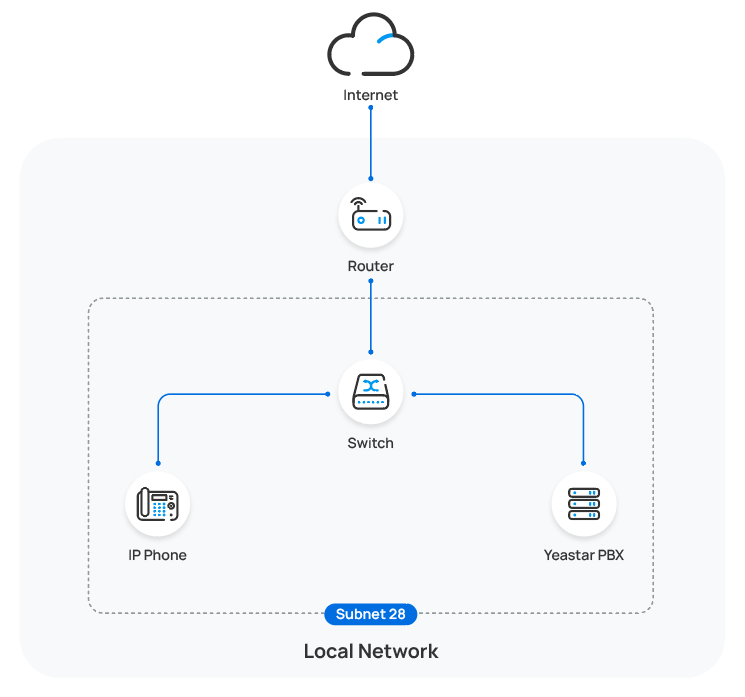
- Prerequisites
-
- Make sure that you have downloaded the template for the desired phone model (Path: ).
- If the IP phone is previously used, you need to RESET the IP phone, then re-configure the network settings for the phone.
- Procedure
-
- Log in to PBX web portal, go to .
The IP phones detected by the PBX via PnP are displayed in the phone list.
- Click
 beside the Grandstream IP
phone.
beside the Grandstream IP
phone.
- Optional: In the Options section,
select a desired template from the Template
drop-down list.Note: You can select the default template corresponding to the phone model, or customize your own template. For more information, see Create a Custom Auto Provisioning Template.
- In the Assign Extension
section, assign an extension to the IP phone.
 Note: If your desired extension is not listed in the drop-down list, it indicates that the extension has been associated with an IP phone or gateway.
Note: If your desired extension is not listed in the drop-down list, it indicates that the extension has been associated with an IP phone or gateway.- To release the extension from the associated IP phone or gateway, see Release an Extension from a Provisioned IP Phone/Gateway.
- To assign the extension to the phone without releasing it from the previously associated device, you can configure the concurrent registration setting for the extension, as the PBX only allows an extension to register with one SIP endpoint by default.
- Click Save.
- Log in to PBX web portal, go to .
- Result
-
Note: Some IP phones will reboot automatically. If not, you need to manually reboot the phone to make the configurations take effect.
- What to do next
- By default, Grandstream IP phone enables all available codecs for its accounts, which may lead to issues with outgoing calls. Therefore, it is recommended to remove unnecessary codecs for the account that has been registered with the PBX extension.
Auto provision a Grandstream IP phone in different subnets (DHCP)
In this example, the Grandstream IP phone and DHCP server are deployed in subnet 28,
while the Yeastar PBX (IP: 192.168.20.58) is deployed in subnet
20.
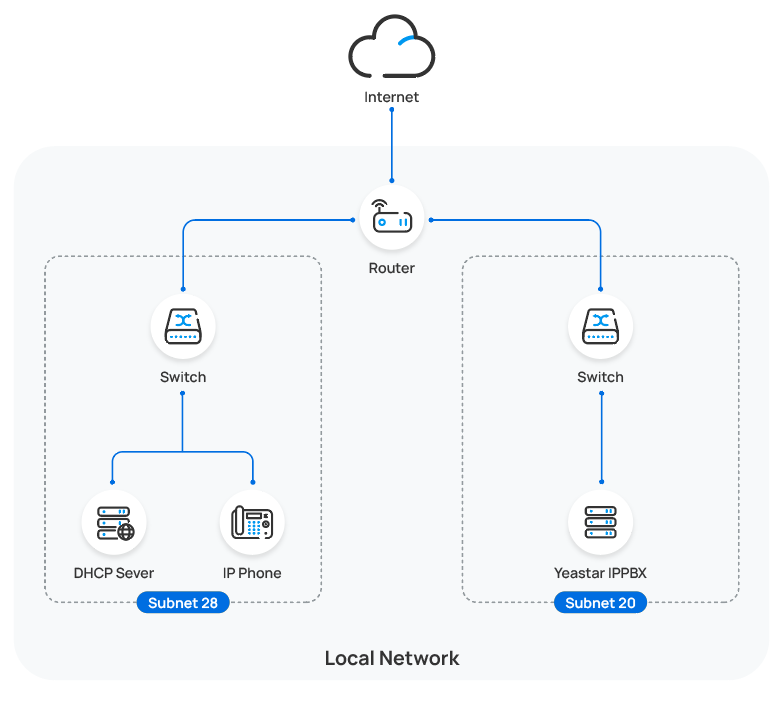
- Prerequisites
-
- Make sure that there is only one DHCP server running in the subnet where the IP phone is deployed, or the IP phone would fail to obtain an IP address.
- Make sure that the IP phone and PBX can communicate with each other over the subnets.
- Make sure that you have downloaded the template for the desired phone model (Path: ).
- RESET the IP phone if it is previously used.
- Gather information of IP phone, including Vendor, Model, and MAC address.
- Procedure
- Step 1. Enable Remote Registration feature for the extension on PBX
- Enable the Remote Registration feature for the extension to be assigned to the phone, so that the extension can be registered in a different subnet.
- Step 2. Add the Grandstream IP phone on PBX
Add the IP phone on PBX. The PBX will generate a configuration file based on the phone's MAC address.
- On PBX web portal, go to .
- Click .
- In the IP Phone section, enter the following
phone information.

- Vendor: Select Grandstream.
- Model: Select the phone model. In this example, select GRP2602.
- MAC Address: Enter the MAC address of the IP phone.
- In the Options section, configure the
following settings.

- Template: Select a desired template
from the drop-down list.Note: You can select the default template corresponding to the phone model, or customize your own template. For more information, see Create a Custom Auto Provisioning Template.
- Provisioning Method: Select
DHCP (In the Office).
A provisioning link is automatically generated and displayed in the Provisioning Link field. This provisioning link points to the location where the phone's configuration file is stored.
- Template: Select a desired template
from the drop-down list.
- In the Assign Extension
section, assign an extension to the IP phone.
 Note: If your desired extension is not listed in the drop-down list, it indicates that the extension has been associated with an IP phone or gateway.
Note: If your desired extension is not listed in the drop-down list, it indicates that the extension has been associated with an IP phone or gateway.- To release the extension from the associated IP phone or gateway, see Release an Extension from a Provisioned IP Phone/Gateway.
- To assign the extension to the phone without releasing it from the previously associated device, you can configure the concurrent registration setting for the extension, as the PBX only allows an extension to register with one SIP endpoint by default.
- Click Save.
- Step 3. Configure DHCP option 66 on DHCP server
In the subnet where the IP phone is deployed, use the generated provisioning link to configure option 66 on the DHCP Server.
- On PBX web portal, copy the provisioning link from the phone's
detail page.

- On the DHCP server, set up option 66 with the
provisioning link.
In this example, the configuration on a router's DHCP server is shown below.
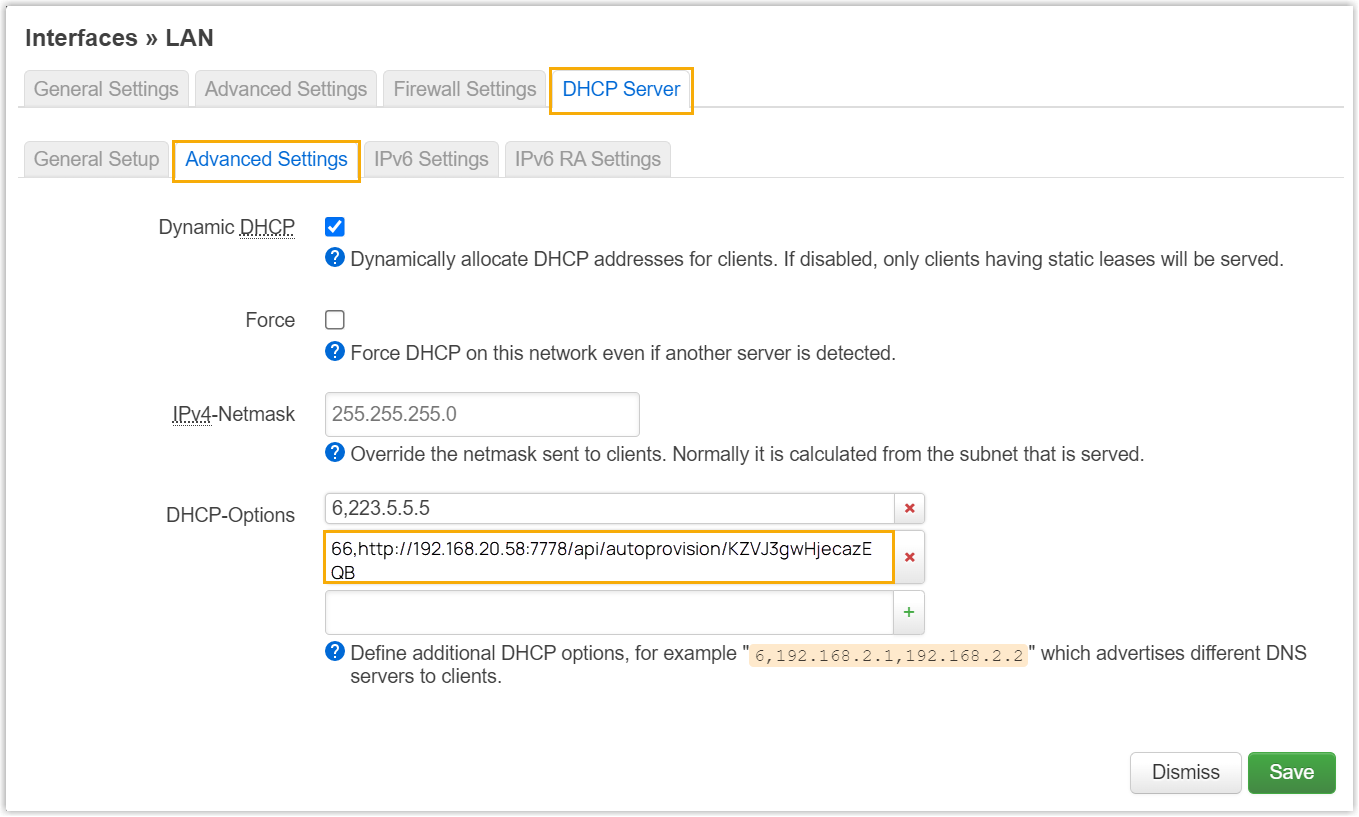
- On PBX web portal, copy the provisioning link from the phone's
detail page.
- Result
-
Note: Some IP phones will reboot automatically. If not, you need to manually reboot the phone to make the configurations take effect.
- What to do next
- By default, Grandstream IP phone enables all available codecs for its accounts, which may lead to issues with outgoing calls. Therefore, it is recommended to remove unnecessary codecs for the account that has been registered with the PBX extension.
Provision a Grandstream IP phone in remote network (Provision Link)
- Prerequisites
-
- Set up a DHCP server in the same subnet as the IP phone to
assign it an IP address.Note: Make sure that there is only one DHCP server running in the subnet, or the IP phone would fail to obtain an IP address.
- Make sure that you have downloaded the template for the desired phone model (Path: ).
- Make sure that you have completed the corresponding settings
shown below according to the network environment of
Grandstream IP phone and Yeastar PBX.
Method Setting Using Yeastar FQDN -
Subscribe to Enterprise Plan or Ultimate Plan for the PBX and ensure the FQDN is available.
-
Grant remote access permission for extension to be registered and the remote IP phones:
- Grant remote SIP access permission for the
extension, so that the extension can be
registered remotely via FQDN (Path: ).
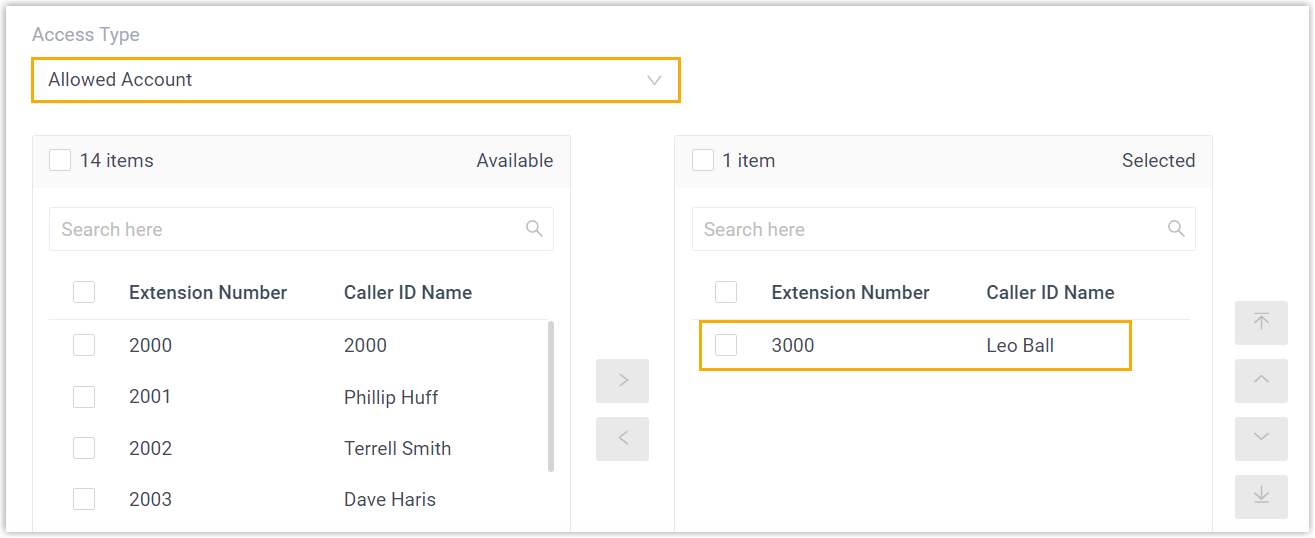
- If you have enabled IP restriction for Yeastar FQDN remote
Web access, make sure that you have added
the phone's IP address to the permitted IP list,
so that the phone can obtain configuration files
from the PBX (Path: ).
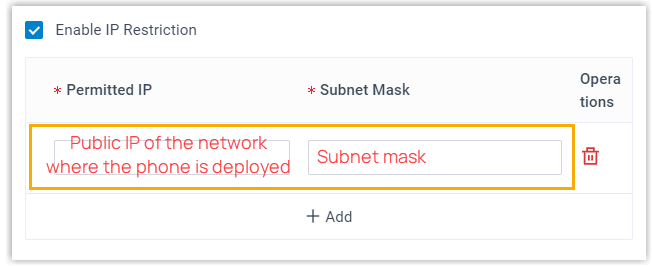
- Grant remote SIP access permission for the
extension, so that the extension can be
registered remotely via FQDN (Path: ).
- Make sure that you have downloaded the template for the desired phone model (Path: ).
- RESET the IP phone if it is previously used.
- Gather information of IP phone, including Vendor, Model, and MAC address.
Using Public IP address / external host / Yeastar domain name - Configure PBX network for remote access
by a public IP address, by an external host domain name, or by a Yeastar domain name.Important: The following PBX ports MUST be forwarded for RPS provisioning.
- RTP ports
- SIP port
- Web Server port
- Set up the extension for remote
registration.
- Enable
NAT
for the extension (Path: ).

- Enable Remote Registration feature for the extension
(Path: ).

- Enable
NAT
for the extension (Path: ).
- Make sure that you have downloaded the template for the desired phone model (Path: ).
- RESET the IP phone if it is previously used.
- Gather information of IP phone, including Vendor, Model, and MAC address.
-
- Set up a DHCP server in the same subnet as the IP phone to
assign it an IP address.
- Procedure
- Step 1. Add the Grandstream IP phone on PBX
-
Add the IP phone on PBX. The PBX will generate a configuration file based on the phone's MAC address.
- Log in to PBX web portal, go to .
- Click .
- In the IP Phone section, enter the following
phone information.

- Vendor: Select Grandstream.
- Model: Select the phone model. In this example, select GRP2602.
- MAC Address: Enter the MAC address of the IP phone.
- In the Options section, configure the
following settings.

- Template: Select a desired
template from the drop-down list.Note: You can select the default template corresponding to the phone model, or customize your own template. For more information, see Create a Custom Auto Provisioning Template.
- Provisioning
Method: Select Provision Link
- FQDN (Remote) or Provision
Link (Remote).The Provisioning Link field displays a provisioning link, which points to the location where the phone's configuration file is stored.Note: Note down the provisioning link, as you will need to use it later when configuring the DHCP server.
- Template: Select a desired
template from the drop-down list.
- In the Assign Extension
section, assign an extension to the IP phone.
 Note: If your desired extension is not listed in the drop-down list, it indicates that the extension has been associated with an IP phone or gateway.
Note: If your desired extension is not listed in the drop-down list, it indicates that the extension has been associated with an IP phone or gateway.- To release the extension from the associated IP phone or gateway, see Release an Extension from a Provisioned IP Phone/Gateway.
- To assign the extension to the phone without releasing it from the previously associated device, you can configure the concurrent registration setting for the extension, as the PBX only allows an extension to register with one SIP endpoint by default.
- Click Save.
- Step 2. Configure DHCP option 66 on DHCP server
- In the subnet where the IP phone is deployed, use the generated
provisioning link to configure option 66 on the DHCP Server.
- On PBX web portal, copy the provisioning link from the
phone's detail page.

- On the DHCP server, set up option 66 with the provisioning
link.
In this example, the configuration is shown below:
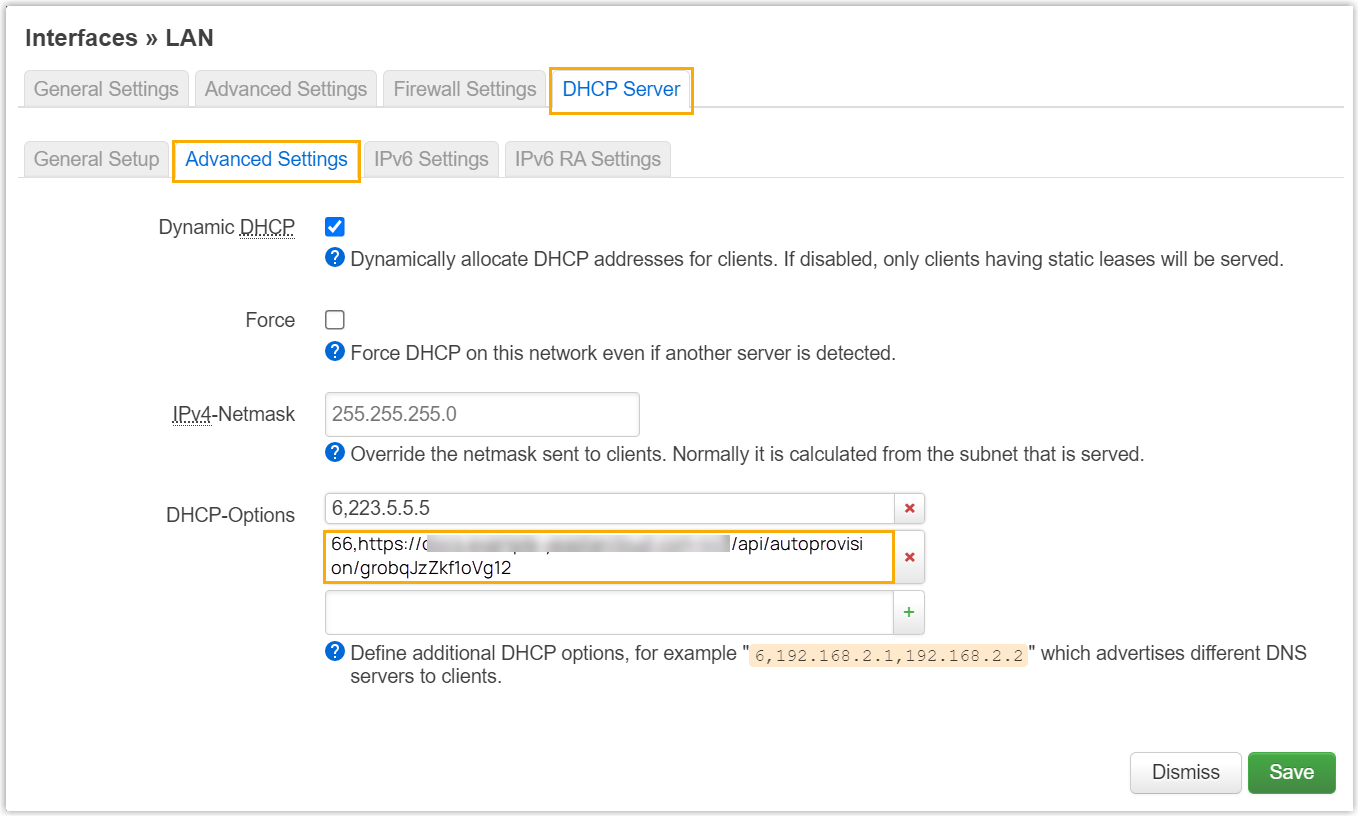
- On PBX web portal, copy the provisioning link from the
phone's detail page.
- Result
-
Note: Some IP phones will reboot automatically. If not, you need to manually reboot the phone to make the configurations take effect.
- What to do next
- By default, Grandstream IP phone enables all available codecs for its accounts, which may lead to issues with outgoing calls. Therefore, it is recommended to remove unnecessary codecs for the account that has been registered with the PBX extension.

